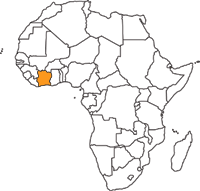 |
National Parks
- Azagny
- Banco
- Comoé
- Iles Ehotile
- Marahoue
- Mont Peko
- Mont Sangbe
- Tai (www)
Wildlife and Flora Reserves
Strict Nature Reserves
Botanical Reserves
- Bamoro
- Bouafle
- Divo
- Kassa
- Katiola
- Moni
- Mont Sangouine
- Mont-Nieton
- N'Ganda-N'Ganda
- Niangbon
- Orumba Boka
- Singrobo
- Tankessé
- Tos
- Yapo
Wetlands of International Importance (Ramsar)
World Heritage Convention
- Comoé National Park
- Mount Nimba Strict Nature Reserve
- Taï National Park (www)
UNESCO-MAB Biosphere Reserves
- Parc National de la Comoé
- Parc national de Taï (www)
Cloud Forest Sites
|
Protected Areas in Côte d'Ivoire
From 1899 to 1960 Côte d'Ivoire was a French colony, which, together with the present day territories of Benin, Burkina Faso, Niger and Mali, formed part of the country of French West Africa.
There are currently two WWF projects running in the country. One is concerned with the management of Taï National Park, the second involves a local non- governmental conservation organisation, La Croix Verte. This is the leading conservation organisation dedicated to environmental protection, conservation education, wildlife preservation and the sustainable use of natural resources.
The Ministry of Water and Forests (Ministère des Eaux et Forêts) is responsible for all protected areas. Comoë and Azagny national parks, which are open to tourism and have protective and administrative infrastructures, are moderately well protected.The levels of protection and management in the other parks and reserves varies from nil to low.
Basically, national parks are subject to two threats: poaching and gold prospecting. Other regular threats are posed by forest exploitation and cultivation of the land by local villagers.
Sources: World Database of Protected Areas, UNEP-WCMC
|
|


